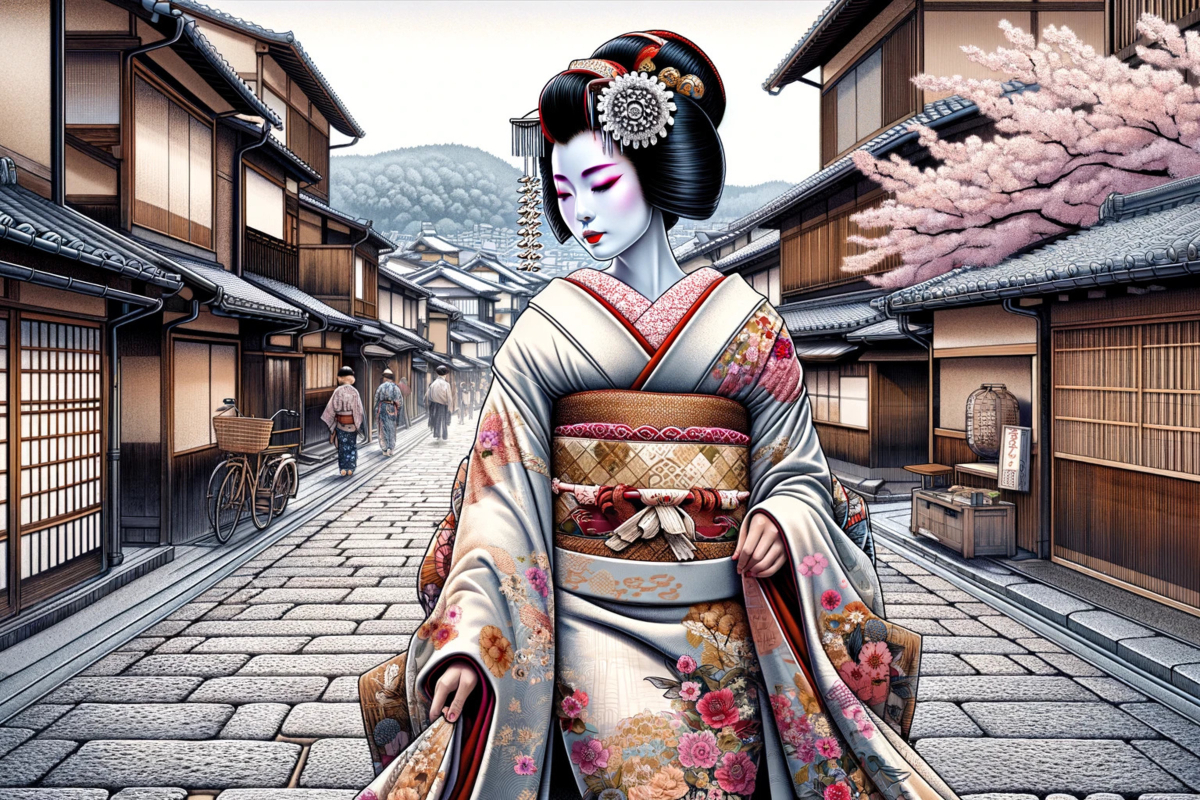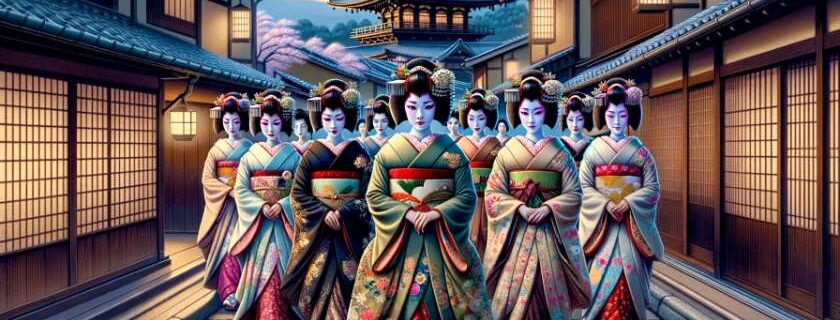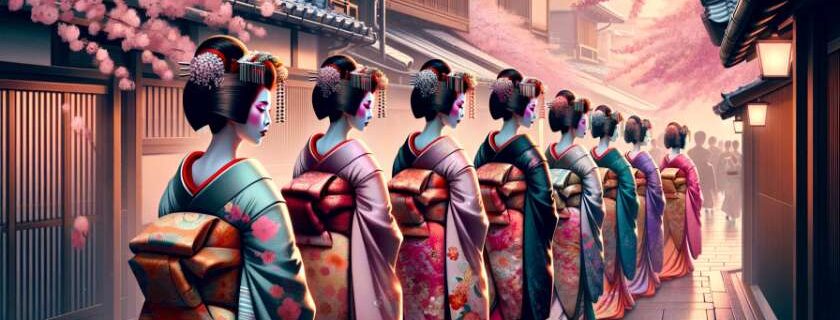
Did you know that Kyoto is home to over 1000 geishas, preserving the ancient art of traditional Japanese entertainment? Delving into the world of Kyoto geishas offers a captivating glimpse into a centuries-old cultural practice. From their meticulously crafted hairstyles to their elegant kimono attire, Kyoto geishas embody grace and sophistication in every movement they make.
Exploring the enigmatic realm of Kyoto geishas unveils a mesmerizing blend of history, tradition, and mystique. Witnessing a geisha’s refined dance or engaging in conversation with one reveals an intriguing tapestry woven with secrets and traditions passed down through generations. Immerse yourself in this unique cultural experience as we unravel the allure and mystique surrounding Kyoto’s iconic geisha community.
- Key Takeaways
- Understanding Geisha Culture in Kyoto
- Exploring the History of Geisha in Kyoto
- Differences Between Maiko and Geiko
- The Training Process of Kyoto Geisha
- Geisha’s Traditional Performances and Dances
- Tips for Spotting Geisha, Geiko, and Maiko in Kyoto
- Private Kyoto Dinner with a Geisha Experience
- Gion Walking Tour: Exploring the Geisha District
- How to Buy Tickets for Geisha Shows in Kyoto
- Summary
- Frequently Asked Questions
- What is the significance of Geisha in Kyoto culture?
- How can one differentiate between Maiko and Geiko?
- Is it possible for tourists to spot Geisha in Kyoto?
- What activities can visitors engage in to experience Geisha culture firsthand?
- Are there specific etiquettes one should observe when interacting with Geishas?
Key Takeaways
- Take the time to understand the deep-rooted traditions and cultural significance of geisha in Kyoto.
- Learn about the key differences between maiko and geiko to appreciate their unique roles and appearances.
- Explore the rigorous training process geisha undergo to master various arts and skills.
- Experience the beauty and grace of geisha through their traditional performances and dances.
- Use the provided tips to spot geisha, geiko, and maiko in Kyoto for a chance to witness their elegance firsthand.
- Consider booking a private dinner with a geisha or joining a Gion walking tour to get a more intimate look into the geisha world.
- If interested in attending geisha shows, follow the guide on how to buy tickets in advance for a seamless experience.

Understanding Geisha Culture in Kyoto
Rich History
Kyoto geisha culture is a captivating tradition that has thrived for centuries, offering a unique window into Japan’s past. These skilled entertainers, known for their grace and elegance, hold a special place in Japanese society. The intricate rituals and performances of geisha in Kyoto exemplify the country’s commitment to preserving its cultural heritage.
The geisha community in Kyoto is deeply rooted in tradition, with strict training and apprenticeships ensuring the continuity of this art form. Geisha[1] are trained not only in traditional arts like dance, music, and tea ceremonies but also in conversation skills and etiquette. This comprehensive training allows them to embody the essence of sophistication and grace that defines the geisha persona.
Cultural Significance
The Kyoto geisha culture, with its emphasis on refinement and beauty, plays a vital role in showcasing Japan’s artistic traditions. By observing a geisha performance or participating in traditional tea ceremonies, visitors can gain insight into the country’s rich cultural tapestry. Geishas’ elaborate attire, distinctive hairstyles, and meticulous makeup all contribute to creating an aura of mystique around these performers.
Visiting Kyoto offers a chance to immerse oneself in this enchanting world where history comes alive through the graceful movements of geishas. From elegant dances accompanied by traditional instruments to engaging conversations steeped in etiquette, every aspect of interacting with a geisha reflects centuries-old customs passed down through generations.
Exploring the History of Geisha in Kyoto
Evolution from Saburuko
Geisha in Kyoto trace their roots back to the 17th century, originating from “saburuko” entertainers during the Edo period. These women evolved into geisha, mastering various arts like dance, music, and conversation. The transition reflected a shift towards refined entertainment for the elite.
The transformation from saburuko to geisha was not just about entertainment but also sophistication. Geisha underwent rigorous training in traditional arts and etiquette. This evolution elevated their status as esteemed performers sought after by nobles and samurai.
Kyoto: Center of Geisha Culture
Kyoto’s prominence in geisha culture stems from its historical significance and imperial court patronage. The city’s rich heritage and ties to Japanese traditions made it an ideal hub for geisha activities. Tourists flock to Kyoto year-round to witness geishas performing at teahouses during cherry blossom season or visit historic shrines where these artists entertain.
Geishas’ presence adds allure to Kyoto’s cultural tapestry, enchanting visitors with graceful performances rooted in centuries-old traditions. Their elegance and skill embody Japan’s artistic legacy while offering a glimpse into a bygone era when refinement reigned supreme.
Differences Between Maiko and Geiko
Training and Status
Maiko are apprentice geisha who go through intensive training to become geiko. They start their training at a young age, learning various arts like dance, music, and tea ceremonies. Once they complete their rigorous apprenticeship, they graduate to become full-fledged geiko. Geiko, on the other hand, have finished their training and are considered senior geisha with advanced skills.
Both maiko and geiko play crucial roles in preserving traditional Japanese arts and culture. While maiko focus on perfecting their art forms during the apprentice period, geikos take on more responsibilities within the community as experienced performers.
- Maiko undergo intense training
- Geikos are senior members with refined skills
Attire Distinctions
One of the most noticeable differences between maikos and geikos is their attire. Maikos wear elaborate, brightly colored kimono with long sleeves that signify their apprentice status. These kimonos feature intricate patterns that represent youthfulness and vitality. In contrast, geikos wear more subtle kimono designs in subdued colors such as dark blue or black to reflect maturity.
The elaborate outfits worn by maikos symbolize their youthful energy while also serving as a way for them to attract attention during performances or events. On the other hand, the elegant yet understated attire of geikos highlights their experience and status within the community.

The Training Process of Kyoto Geisha
Early Start
Geisha training, or shikomi, begins at a young age and can span several years. Trainees immerse themselves in traditional arts like dance, music, tea ceremonies, and social etiquette. This intensive learning period is crucial for mastering the skills required to become a geisha.
Living in an okiya during training is common practice. Under the guidance of a senior geisha or the okasan (mother), apprentices receive hands-on instruction on various aspects of being a geisha. This close mentorship ensures that trainees absorb not only the technical skills but also the cultural nuances essential to their profession.
Comprehensive Education
The journey from apprentice to full-fledged geisha involves meticulous attention to detail and dedication over an extended period. Trainees devote themselves entirely to honing their craft, often balancing rigorous practice schedules with academic studies up until middle school before committing fully to their geisha training.
The process includes donning elaborate costumes and mastering intricate makeup techniques such as applying the iconic white makeup associated with geishas. Through repetitive practice sessions and performances at different events, apprentices gradually refine their skills under the watchful eye of experienced mentors.
Geisha’s Traditional Performances and Dances
Odori Dances
Geisha engage in geisha dances known as “odori” during their performances. Each dance conveys a unique message through elegant movements and gestures. These traditional dances are deeply rooted in Japanese culture, showcasing the grace and skill of geisha.
- Pros:
- Preserves Japanese cultural heritage
- Captivates audiences with storytelling through dance
- Cons:
- Requires years of training to master
- Limited opportunities for young women to become geisha
Meaningful Movements
The art of geisha shows involves more than just dancing; it is a form of storytelling through movement. Geisha use precise gestures and expressions to convey emotions and narratives, captivating their audience with each graceful step.
- Traditional Instruments:
- Shamisen, a three-stringed instrument, accompanies geisha performances.
- The melodic tunes enhance the atmosphere of the performance, adding depth to the storytelling.
- Cultural Significance:
- Geisha play a vital role in preserving Japan’s traditional arts.
- Through their dance performances, they keep ancient stories alive while showcasing the beauty of Japanese culture.
Tips for Spotting Geisha, Geiko, and Maiko in Kyoto
Visit Gion District
When you’re in Kyoto and eager to catch a glimpse of kyoto geisha, head straight to the Gion district. This area is renowned as the hub of geisha culture. Strolling through its narrow streets increases your chances of encountering these traditional entertainers. Keep an eye out for elegantly dressed women sporting intricate kimonos, elaborate hairstyles, and striking white makeup.
Evening Sightings
If you want to enhance your likelihood of spotting a kyoto geisha, plan your visit during the evening hours. Geishas are more visible at night when they attend various engagements or events around the district. The dimly lit lanterns casting a soft glow on the cobbled streets create an enchanting atmosphere where these graceful figures often make appearances.
Exploring Kyoto’s Gion district offers unique opportunities to witness geishas going about their daily routines or heading to appointments. Immerse yourself in this cultural experience by observing how they move with poise and grace along the historic streets, embodying centuries-old traditions that continue to captivate visitors from around the world.

Private Kyoto Dinner with a Geisha Experience
Authentic Experience
Booking a private dinner in Kyoto offers an exclusive geisha experience. You can enjoy the elegance and grace of geisha while savoring traditional Japanese cuisine, such as kaiseki.
Immerse yourself in the ambiance of historic tea houses, where geishas have entertained guests for centuries. The intimate setting allows you to appreciate their artistry up close.
Interaction Opportunity
Private dinners create a unique chance to engage with geishas on a personal level. You can converse with them, ask questions about their craft, and even learn about their daily lives beyond performances.
Witness firsthand the intricate rituals of tea service and banquets that are part of the geisha world. These interactions may deepen your understanding and appreciation for this ancient tradition.
Gion Walking Tour: Exploring the Geisha District
Guided Walking Tour
Embark on a walking tour in the enchanting Gion district to immerse yourself in the captivating world of geisha culture. A knowledgeable tour guide will lead you through the historic streets, offering insights into the rich traditions and practices of geisha entertainment. As you stroll along, observe traditional machiya houses and teahouses where geisha entertain guests with their grace and artistry.
Uncover intriguing details about this unique cultural phenomenon as your guide shares stories about the daily lives and rigorous training of geishas. The guided tour provides a rare opportunity to witness firsthand how these skilled performers uphold centuries-old customs in modern times.
Hidden Gems
Delve into the heart of Gion’s allure by exploring its hidden gems, such as the renowned Hanamikoji Street. This bustling street is synonymous with elegance and sophistication, known for its picturesque beauty and vibrant atmosphere that transport visitors back in time. Take in the sights and sounds of this iconic location where geishas gracefully move between teahouses, creating an ambiance unlike any other.
Immerse yourself in the authenticity of Hanamikoji Street as you admire its traditional architecture and quaint shops selling local crafts. Capture moments of tranquility amidst the bustling city life while gaining a deeper appreciation for Kyoto’s cultural heritage preserved within these charming streets.
How to Buy Tickets for Geisha Shows in Kyoto
Purchase Tickets
To secure tickets for geisha shows in Kyoto, head to designated ticket offices or reputable online platforms. These avenues offer a convenient way to purchase tickets hassle-free. Whether you prefer the traditional approach of buying tickets in person or the ease of online booking, both options are available for your convenience.
When planning to attend a geisha show at renowned venues like Gion Corner or Pontocho Kaburenjo Theater, acquiring tickets beforehand is highly recommended. By purchasing tickets in advance, you ensure that you have guaranteed entry into these popular venues known for their captivating geisha performances.
Popular Venues
Gion Corner and Pontocho Kaburenjo Theater stand out as two of the most sought-after locations to witness authentic geisha performances in Kyoto. At Gion Corner, visitors can immerse themselves in cultural showcases featuring various traditional arts such as tea ceremonies and flower arranging alongside mesmerizing geisha dances. On the other hand, Pontocho Kaburenjo Theater offers an intimate setting where guests can appreciate the grace and elegance of geisha performances up close.
- Key Points:
- Secure tickets from designated offices or online.
- Book ahead when attending shows at Gion Corner or Pontocho Kaburenjo Theater.

Summary
You’ve dived deep into the captivating world of Kyoto’s geisha culture. From understanding the rich history to spotting geisha in action, you’ve uncovered the secrets behind these mysterious entertainers. By exploring their training process, traditional performances, and even experiencing a private dinner with a geisha, you’ve gained valuable insights into this ancient art form. Now equipped with tips on how to spot geisha and where to enjoy their shows, you’re ready to immerse yourself in the enchanting realm of Kyoto’s geisha districts. Take this newfound knowledge and venture into Gion, where every corner holds a piece of geisha history waiting to be discovered.
Frequently Asked Questions
What is the significance of Geisha in Kyoto culture?
Geisha play a vital role in preserving traditional Japanese arts and entertainment. They are skilled performers trained in various art forms like dance, music, and conversation, adding elegance to cultural events and gatherings.
How can one differentiate between Maiko and Geiko?
Maiko are apprentice geisha characterized by their elaborate kimono with long sleeves (furisode) and vibrant obi sash tied at the back. On the other hand, geiko are fully-fledged geisha who wear more subdued attire reflecting their seniority.
Is it possible for tourists to spot Geisha in Kyoto?
While encountering geisha randomly on the streets is rare due to their busy schedules, areas like Gion offer better chances during evening hours as they move between teahouses. Respect their privacy by observing quietly from a distance.
What activities can visitors engage in to experience Geisha culture firsthand?
Visitors can partake in authentic experiences such as private dinners or tea ceremonies with geishas where they showcase traditional performances and interact intimately. Booking through reputable agencies ensures genuine encounters while supporting this rich cultural heritage.
Are there specific etiquettes one should observe when interacting with Geishas?
Respectful behavior is crucial when engaging with geishas. Avoid taking photos without permission, maintain a polite demeanor, refrain from touching their accessories or kimono, and appreciate their artistry graciously to foster a pleasant interaction for both parties.




